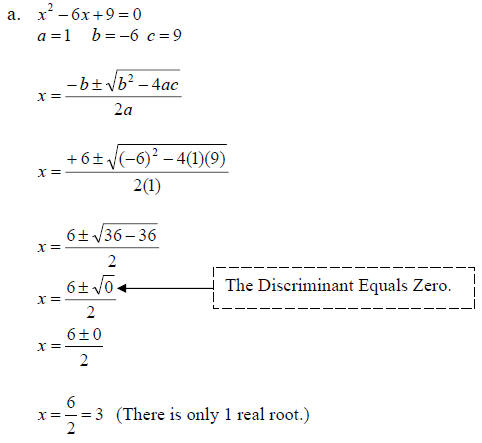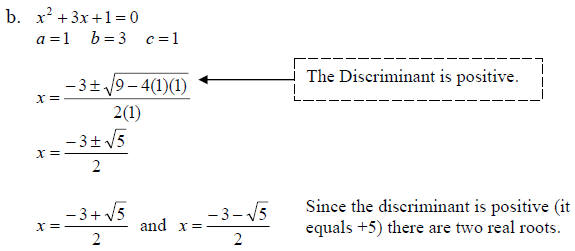Roots of Quadratic Equations
I. Finding Roots of Quadratic Equations
a. The Standard Form of a quadratic equation is: ax2 + bx + c = 0 .
b. We can use the Quadratic Formula to solve equations in standard
form:

c. Discriminant – The radical portion of this
formula sqrt(b2 − 4ac) ,
determines the nature of the roots. This quantity under the radical
sign b2 − 4ac , is called the discriminant.

d. Three things may occur regarding the discriminant:
i. If b2 − 4ac > 0
We can take the square root of this positive amount
and there will be two different real answers (or roots)
to the equation.
ii. If b2 − 4ac < 0
We cannot take the square root of a negative number,
so there will be no real roots.
iii. If b2 − 4ac = 0
The amount under the radical is zero and since the
square root of zero is zero, we will get only 1 distinct
real root.
II. Examples



III. Practice Problems
By examining the discriminant = b2 − 4ac , determine how many real
roots, if any, the following quadratic equations have.
1. x2 − 4x + 4 = 0
2. x2 + 4 = 0
3. x2 − 2x + 4 = 0
4. x2 − 4x = 0
5. 5r2 − 3r + 2 = 0
6. 7x2 −10x − 5 = 0
7. x2 − 4 = 0
8. 25t2 −10t = −1
9. 6y2 − 5y = 21
10. 2y2 −19y = 3
Answers: Roots of Quadratic Equations
1. 1 real root
2. no real roots
3. no real roots
4. 2 real roots
5. no real roots
6. 2 real roots
7. 2 real roots
8. 1 real root
9. 2 real roots
10. 2 real roots